译林版(2019)必修一:Unit 4 Looking good, feeling good 单元教案(表格式)
文档属性
| 名称 | 译林版(2019)必修一:Unit 4 Looking good, feeling good 单元教案(表格式) | 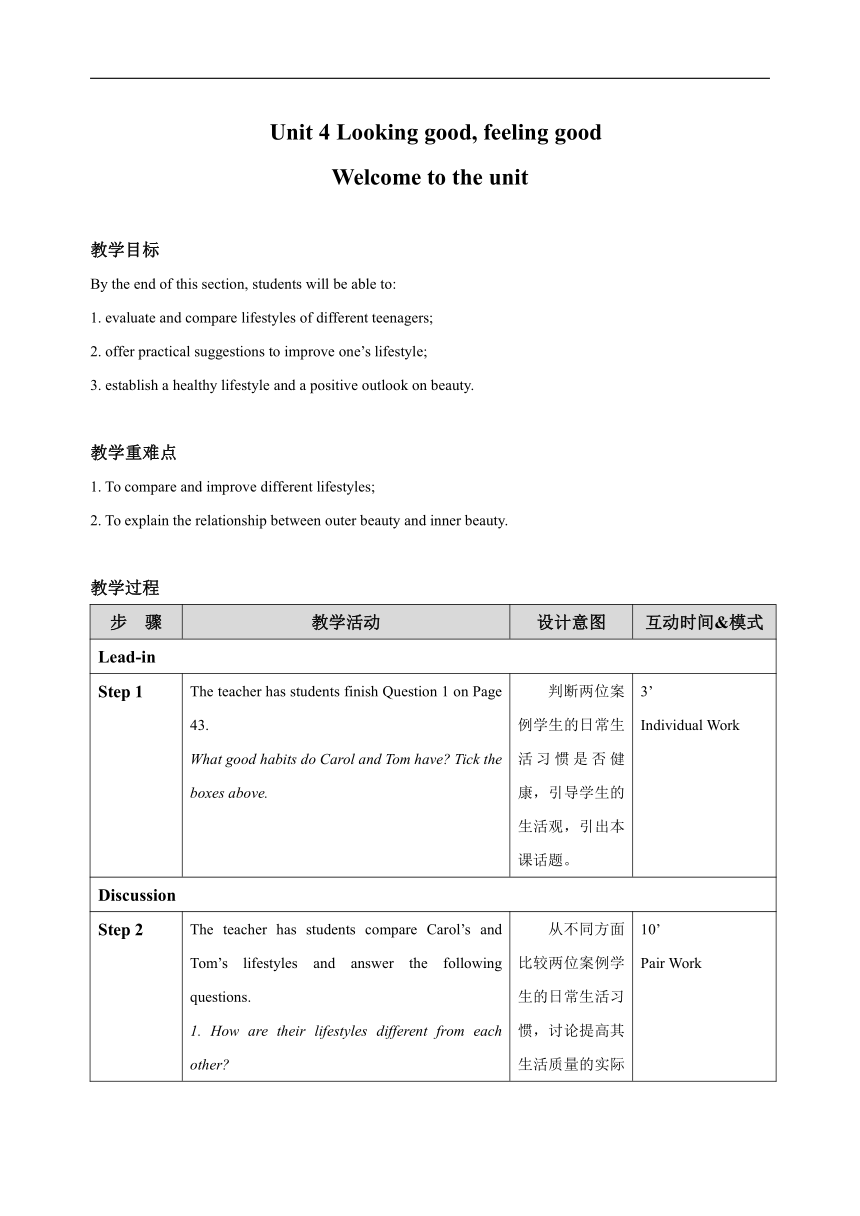 | |
| 格式 | doc | ||
| 文件大小 | 118.0KB | ||
| 资源类型 | 教案 | ||
| 版本资源 | 牛津译林版(2019) | ||
| 科目 | 英语 | ||
| 更新时间 | 2021-09-29 17:01:18 | ||
图片预览

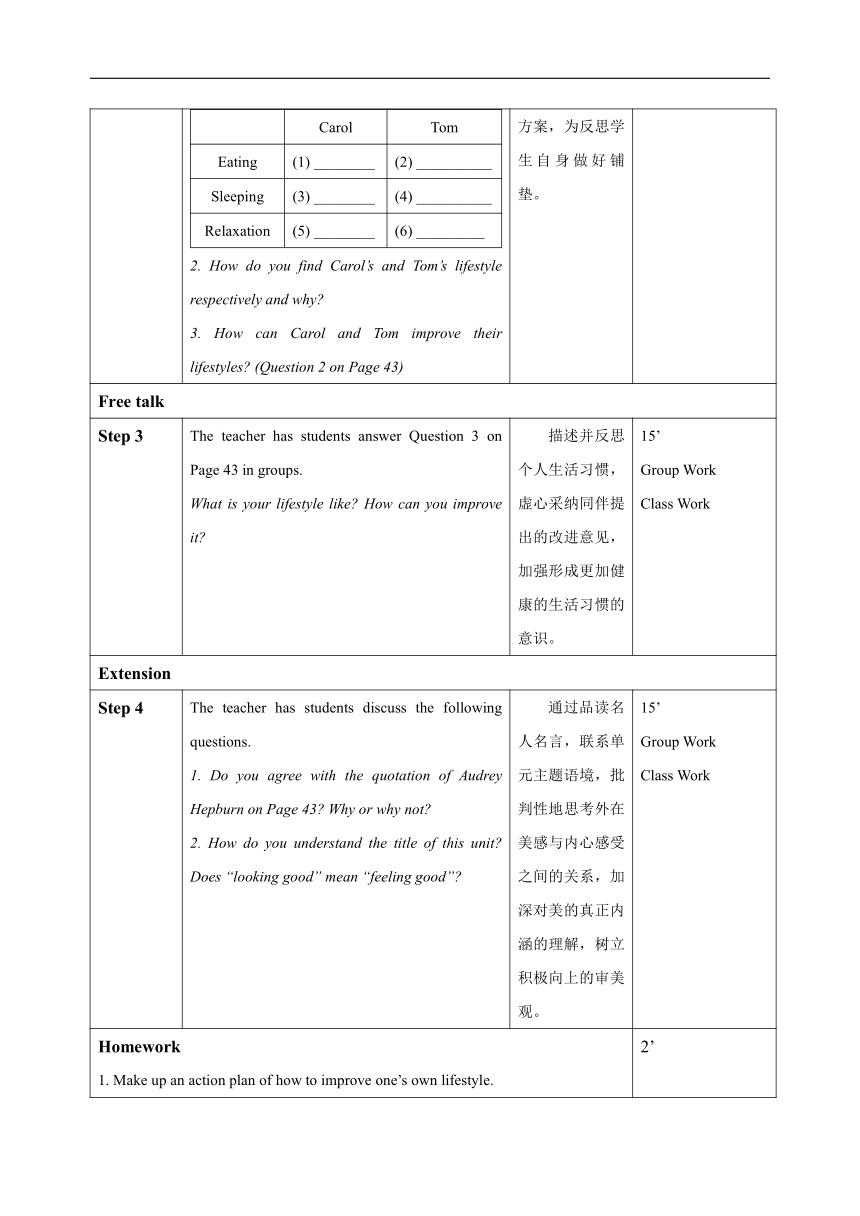
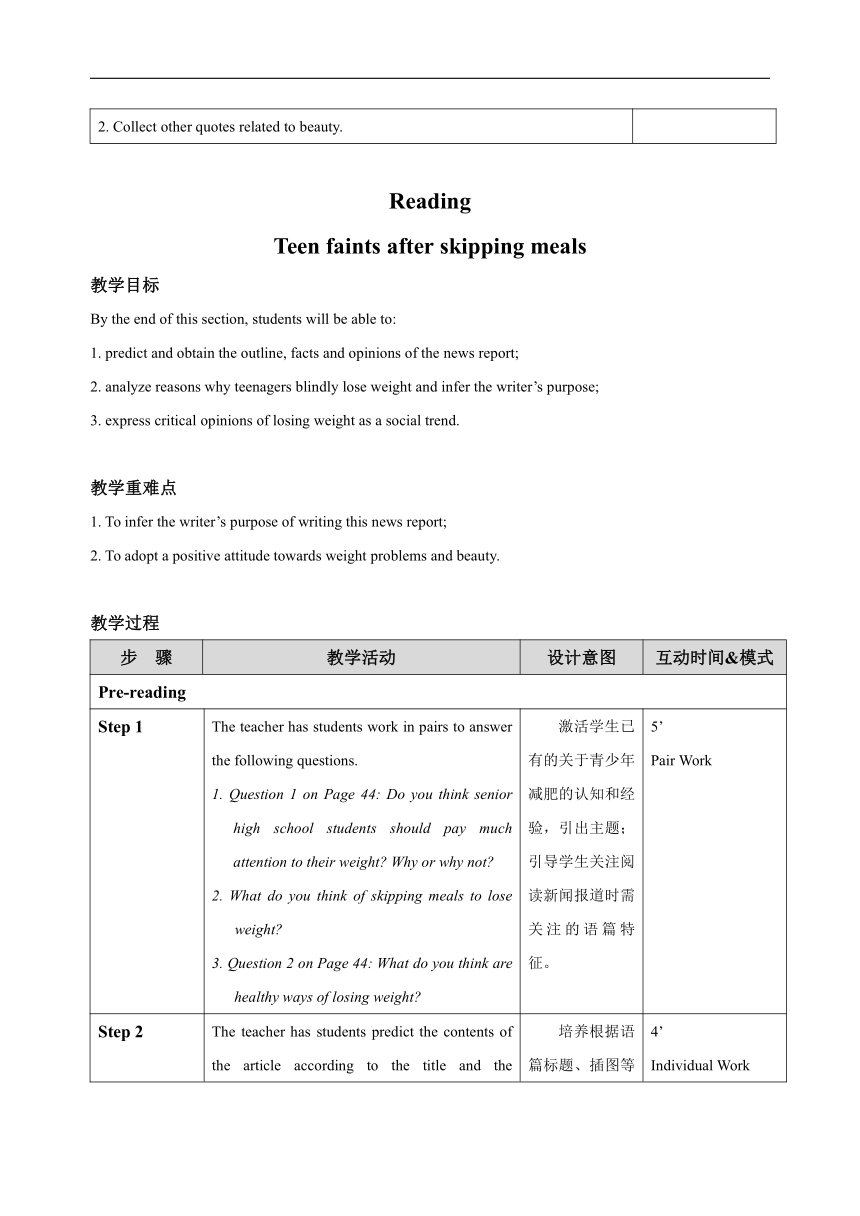
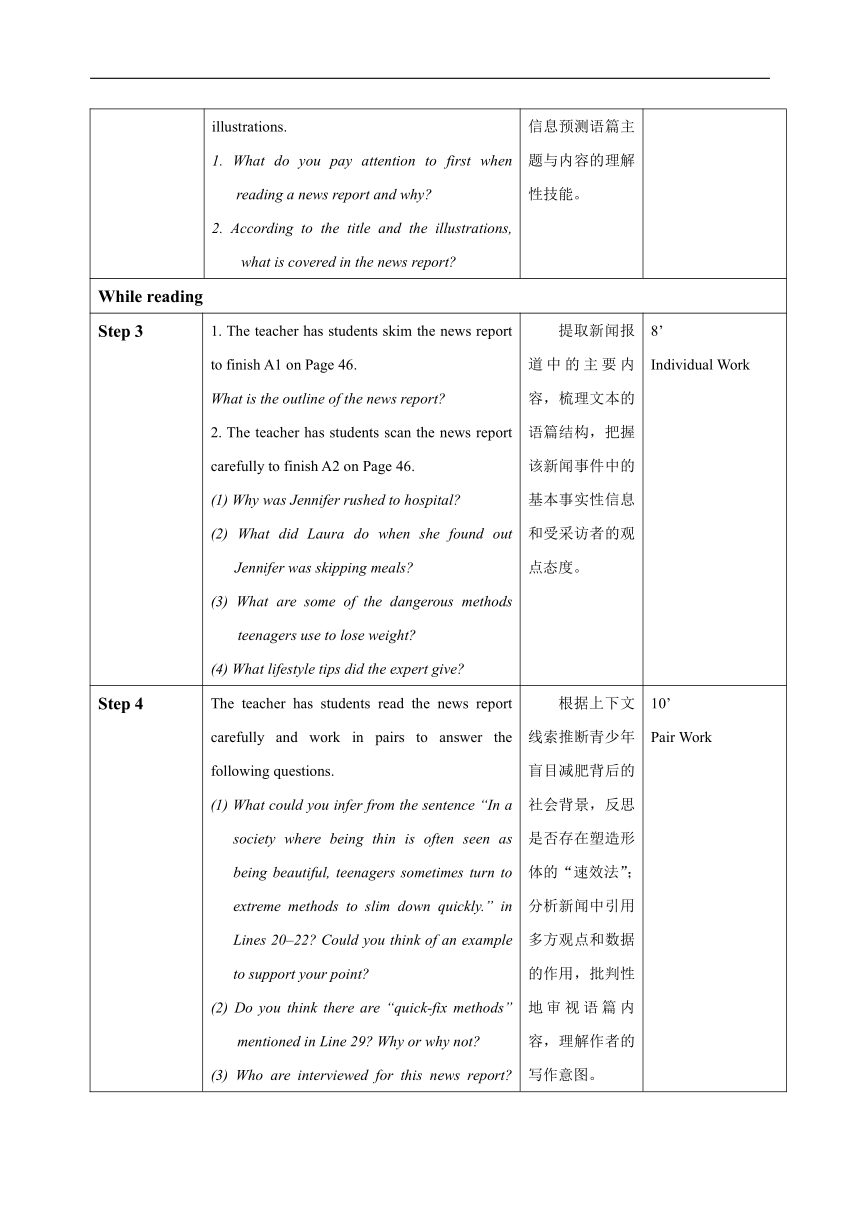
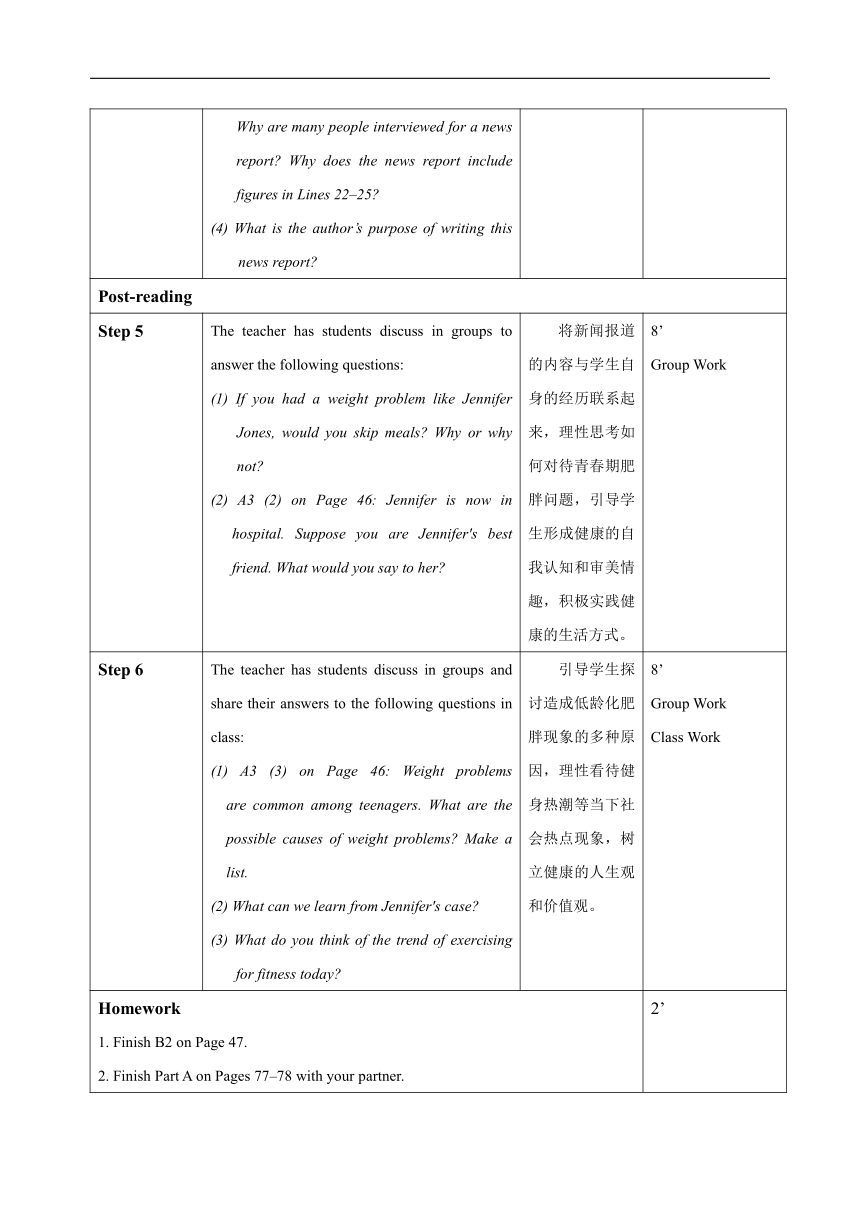
文档简介
Unit
4
Looking
good,
feeling
good
Welcome
to
the
unit
教学目标
By
the
end
of
this
section,
students
will
be
able
to:
1.
evaluate
and
compare
lifestyles
of
different
teenagers;
2.
offer
practical
suggestions
to
improve
one’s
lifestyle;
3.
establish
a
healthy
lifestyle
and
a
positive
outlook
on
beauty.
教学重难点
1.
To
compare
and
improve
different
lifestyles;
2.
To
explain
the
relationship
between
outer
beauty
and
inner
beauty.
教学过程
步
骤
教学活动
设计意图
互动时间&模式
Lead-in
Step
1
The
teacher
has
students
finish
Question
1
on
Page
43.What
good
habits
do
Carol
and
Tom
have
Tick
the
boxes
above.
判断两位案例学生的日常生活习惯是否健康,引导学生的生活观,引出本课话题。
3’Individual
Work
Discussion
Step
2
The
teacher
has
students
compare
Carol’s
and
Tom’s
lifestyles
and
answer
the
following
questions.1.
How
are
their
lifestyles
different
from
each
other
CarolTomEating(1)
________(2)
__________Sleeping(3)
________(4)
__________Relaxation(5)
________(6)
_________2.
How
do
you
find
Carol’s
and
Tom’s
lifestyle
respectively
and
why
3.
How
can
Carol
and
Tom
improve
their
lifestyles
(Question
2
on
Page
43)
从不同方面比较两位案例学生的日常生活习惯,讨论提高其生活质量的实际方案,为反思学生自身做好铺垫。
10’Pair
Work
Free
talk
Step
3
The
teacher
has
students
answer
Question
3
on
Page
43
in
groups.What
is
your
lifestyle
like
How
can
you
improve
it
描述并反思个人生活习惯,虚心采纳同伴提出的改进意见,加强形成更加健康的生活习惯的意识。
15’Group
WorkClass
Work
Extension
Step
4
The
teacher
has
students
discuss
the
following
questions.1.
Do
you
agree
with
the
quotation
of
Audrey
Hepburn
on
Page
43
Why
or
why
not 2.
How
do
you
understand
the
title
of
this
unit
Does
“looking
good”
mean
“feeling
good”
通过品读名人名言,联系单元主题语境,批判性地思考外在美感与内心感受之间的关系,加深对美的真正内涵的理解,树立积极向上的审美观。
15’Group
WorkClass
Work
Homework1.
Make
up
an
action
plan
of
how
to
improve
one’s
own
lifestyle.2.
Collect
other
quotes
related
to
beauty.
2’
Reading
Teen
faints
after
skipping
meals
教学目标
By
the
end
of
this
section,
students
will
be
able
to:
1.
predict
and
obtain
the
outline,
facts
and
opinions
of
the
news
report;
2.
analyze
reasons
why
teenagers
blindly
lose
weight
and
infer
the
writer’s
purpose;
3.
express
critical
opinions
of
losing
weight
as
a
social
trend.
教学重难点
1.
To
infer
the
writer’s
purpose
of
writing
this
news
report;
2.
To
adopt
a
positive
attitude
towards
weight
problems
and
beauty.
教学过程
步
骤
教学活动
设计意图
互动时间&模式
Pre-reading
Step
1
The
teacher
has
students
work
in
pairs
to
answer
the
following
questions.1.
Question
1
on
Page
44:
Do
you
think
senior
high
school
students
should
pay
much
attention
to
their
weight
Why
or
why
not 2.
What
do
you
think
of
skipping
meals
to
lose
weight 3.
Question
2
on
Page
44:
What
do
you
think
are
healthy
ways
of
losing
weight
激活学生已有的关于青少年减肥的认知和经验,引出主题;引导学生关注阅读新闻报道时需关注的语篇特征。
5’Pair
Work
Step
2
The
teacher
has
students
predict
the
contents
of
the
article
according
to
the
title
and
the
illustrations.1.
What
do
you
pay
attention
to
first
when
reading
a
news
report
and
why 2.
According
to
the
title
and
the
illustrations,
what
is
covered
in
the
news
report
培养根据语篇标题、插图等信息预测语篇主题与内容的理解性技能。
4’Individual
Work
While
reading
Step
3
1.
The
teacher
has
students
skim
the
news
report
to
finish
A1
on
Page
46.What
is
the
outline
of
the
news
report 2.
The
teacher
has
students
scan
the
news
report
carefully
to
finish
A2
on
Page
46.(1)
Why
was
Jennifer
rushed
to
hospital (2)
What
did
Laura
do
when
she
found
out
Jennifer
was
skipping
meals (3)
What
are
some
of
the
dangerous
methods
teenagers
use
to
lose
weight (4)
What
lifestyle
tips
did
the
expert
give
提取新闻报道中的主要内容,梳理文本的语篇结构,把握该新闻事件中的基本事实性信息和受采访者的观点态度。
8’Individual
Work
Step
4
The
teacher
has
students
read
the
news
report
carefully
and
work
in
pairs
to
answer
the
following
questions.(1)
What
could
you
infer
from
the
sentence
“In
a
society
where
being
thin
is
often
seen
as
being
beautiful,
teenagers
sometimes
turn
to
extreme
methods
to
slim
down
quickly.”
in
Lines
20–22
Could
you
think
of
an
example
to
support
your
point (2)
Do
you
think
there
are
“quick-fix
methods”
mentioned
in
Line
29
Why
or
why
not
(3)
Who
are
interviewed
for
this
news
report
Why
are
many
people
interviewed
for
a
news
report
Why
does
the
news
report
include
figures
in
Lines
22–25 (4)
What
is
the
author’s
purpose
of
writing
this
news
report
根据上下文线索推断青少年盲目减肥背后的社会背景,反思是否存在塑造形体的“速效法”;分析新闻中引用多方观点和数据的作用,批判性地审视语篇内容,理解作者的写作意图。
10’Pair
Work
Post-reading
Step
5
The
teacher
has
students
discuss
in
groups
to
answer
the
following
questions:(1)
If
you
had
a
weight
problem
like
Jennifer
Jones,
would
you
skip
meals
Why
or
why
not (2)
A3
(2)
on
Page
46:
Jennifer
is
now
in
hospital.
Suppose
you
are
Jennifer's
best
friend.
What
would
you
say
to
her
将新闻报道的内容与学生自身的经历联系起来,理性思考如何对待青春期肥胖问题,引导学生形成健康的自我认知和审美情趣,积极实践健康的生活方式。
8’Group
Work
Step
6
The
teacher
has
students
discuss
in
groups
and
share
their
answers
to
the
following
questions
in
class:(1)
A3
(3)
on
Page
46:
Weight
problems
are
common
among
teenagers.
What
are
the
possible
causes
of
weight
problems
Make
a
list.(2)
What
can
we
learn
from
Jennifer's
case (3)
What
do
you
think
of
the
trend
of
exercising
for
fitness
today
引导学生探讨造成低龄化肥胖现象的多种原因,理性看待健身热潮等当下社会热点现象,树立健康的人生观和价值观。
8’Group
WorkClass
Work
Homework1.
Finish
B2
on
Page
47.2.
Finish
Part
A
on
Pages
77–78
with
your
partner.
2’
Grammar
and
usage
Restrictive
relative
clauses
with
relative
adverbs
教学目标
By
the
end
of
this
section,
students
will
be
able
to:
1.
explain
meanings
and
basic
grammatical
rules
of
restrictive
relative
clauses
with
relative
adverbs;
2.
properly
apply
restrictive
relative
clauses
with
relative
adverbs
in
contexts;
3.
learn
more
grammatical
rules
of
restrictive
relative
clauses
with
relative
adverbs;
4.
increase
the
awareness
of
a
good
sleep
as
part
of
a
healthy
lifestyle.
教学重难点
1.
To
distinguish
restrictive
relative
clauses
with
relative
adverbs
and
those
with
relative
pronouns;
2.
To
learn
special
usages
of
where
and
when
to
introduce
restrictive
relative
clauses.
教学过程
步
骤
教学活动
设计意图
互动时间&模式
Lead-in
Step
1
1.
The
teacher
has
students
define
a
restrictive
relative
clause,
list
relative
pronouns
and
explain
their
rules.(1)
What
is
a
restrictive
relative
clause (2)
What
can
introduce
a
restrictive
relative
clause (3)
How
do
these
words
introduce
a
restrictive
relative
clause (4)
Could
you
split
the
underlined
sentence
into
two
simple
sentences (5)
Could
you
join
the
two
sentences
above 2.
The
teacher
has
students
analyze
the
function
of
why
as
a
relative
adverb
to
introduce
a
restrictive
relative
clause.
联系第三单元关于“由关系代词引导的限制性定语从句”的语法知识,结合第四单元Reading语篇中的例句,自主分析由关系副词引导的限制性定语从句的含义及基本规则。
3’Individual
Work
Exploring
the
rules
Step
2
1.
The
teacher
has
students
find
out
and
rewrite
all
restrictive
relative
clauses
with
relative
adverbs
in
the
article
on
Page
48.(1)
Could
you
find
out
all
the
restrictive
relative
clauses
with
relative
adverbs
in
the
article (2)
Could
you
rewrite
all
these
restrictive
relative
clauses 2.
The
teacher
guides
students
to
work
out
the
rules
on
Page
48.3.
The
teacher
offers
students
more
rules
of
restrictive
relative
clauses
with
relative
adverbs.
在与单元主题语境关联的“世界睡眠日”的新语篇中理解关系副词when、where、why引导的限制性定语从句,在教师的引导下自主归纳基本规则,并拓展学习相关语法重难点。
10’Individual
WorkPair
Work
Applying
the
rules
Step
3
1.
The
teacher
has
students
finish
B1
on
Page
49.Could
you
rewrite
the
sentences
in
B1
on
Page
49
using
a
relative
adverb
or
“preposition
+
which” 2.
Teacher
has
students
finish
B2
on
Page
49.Could
you
complete
the
passage
in
B2
on
Page
49
with
correct
relative
pronouns
or
relative
adverbs
where
necessary 3.
The
teacher
has
students
finish
B3
on
Page
49.Could
you
write
a
short
paragraph
about
World
Sleep
Day
based
on
the
information
in
B3,
using
restrictive
relative
clauses
where
necessary
以“睡眠”为话题,通过单句改写练习、A部分杂志文章的续写填空、话题写作,操练when、where、why引导的限制性定语从句,以期实现“形式—意义—使用”三者的统一,形成健康的生活方式、积极的生活态度。
20’Individual
Work
Step
4
1.
The
teacher
guides
students
to
choose
the
proper
preposition.2.
The
teacher
guides
students
to
compare
relative
pronouns
and
relative
adverbs
after
the
same
antecedent.3.
The
teacher
guides
students
to
understand
special
usages
of
where
and
when.
针对限定性定语从句中的重难点,拓展相关语法知识,构建限定性定语从句语法体系。
10’Class
Work
Homework1.
Go
through
the
grammar
notes
on
Pages
99–100.2.
Finish
Part
C
on
Page
76.
2’
Integrated
skills
Expressing
your
opinion
about
plastic
surgery
教学目标
By
the
end
of
this
section,
students
will
be
able
to:
1.
analyze
advantages
and
disadvantages
of
plastic
surgery;
2.
support
one’s
attitudes
towards
plastic
surgery
with
reasons.
教学重难点
1.
To
practice
one’s
listening,
reading
and
speaking
skills
in
contexts;
2.
To
form
independent
and
critical
attitudes
towards
plastic
surgery.
教学过程
步
骤
教学活动
设计意图
互动时间&模式
Lead-in
Step
1
The
teacher
has
students
share
their
previous
knowledge
of
plastic
surgery.How
much
do
you
know
about
plastic
surgery
创设情境,引出主题,帮助学生理解“整形手术”这一关键词汇。
5’Class
Work
Reading
Step
2
The
teacher
has
students
read
two
news
stories
about
plastic
surgery
in
Part
A
on
Page
50
and
answer
the
following
questions.(1)
How
did
the
plastic
surgery
help
John
Wilson (2)
What
problems
did
the
plastic
surgery
bring
to
Ella
Edwards
进一步巩固阅读新闻语篇的理解性技能,提取两则新闻故事中的主要信息和观点。
12’Individual
Work
Viewing
Step
3
The
teacher
has
students
listen
to
the
audios
about
Alice’s
news
report
on
plastic
surgery
in
Part
B
on
Page
51
and
finish
B1
and
B2.(1)
Are
the
following
statements
true
(T),
false
(F)
or
not
mentioned
(NG) (2)
Could
you
complete
the
following
notes
训练“听”的理解性技能,获取新闻报道中的主要内容、语篇结构和说话意图。
13’Individual
Work
Speaking
Step
4
The
teacher
has
students
work
in
pairs
to
discuss
plastic
surgery,
using
the
expressions
in
Part
C
on
Page
52.(1)
Are
you
for
or
against
plastic
surgery
Why (2)
What
examples
can
you
think
of
to
support
your
opinion
借助词汇衔接手段,运用得体的语言表达个人关于整形手术利弊的态度,增加语用知识,提高表达性技能。
13’Pair
Work
Homework1.
Preview
Part
D
on
Page
52.2.
Find
more
evidence
to
support
your
opinion.
2’
Project
Designing
an
app
about
a
healthy
lifestyle
教学目标
By
the
end
of
this
section,
students
will
be
able
to:
1.
design
an
app
about
a
healthy
lifestyle
through
exploration
and
cooperation;
2.
present
the
design
rationale
and
the
outcome
of
each
group’s
work
in
class;
3.
evaluate
and
help
improve
each
group’s
work.
教学重难点
To
enhance
one’s
abilities
of
innovative
and
cooperative
learning.
教学过程
步
骤
教学活动
设计意图
互动时间&模式
Preparation
Step
1
1.
The
teacher
has
students
discuss
in
class
various
apps
about
healthy
lifestyle
in
smart
phones
and
explain
their
favourite
ones
with
reasons.
What
apps
about
healthy
lifestyle
have
you
used
Which
is
your
favourite
one
and
why 2.
The
teacher
has
students
work
in
groups
to
review
what
they
have
learned
about
the
theme
of
“a
healthy
lifestyle”
using
a
mind-map.What
have
you
learned
about
“healthy
lifestyle” 3.
The
teacher
has
students
form
groups
of
four
to
pick
one
aspect
about
a
healthy
lifestyle
to
research
into.
Students
can
turn
to
Part
A
on
Page
55
for
reference.
What
aspects
of
a
healthy
lifestyle
is
your
group
going
to
research
into
创设语境,激活学生已有的关于健康生活手机应用程序的认知和经验;复习单元话题“青少年身体与心理健康”下的词汇知识、语法知识、语篇知识和语用知识,帮助学生构建单元学习与应用框架;引导学生共同决定手机应用程序的研究重点,培养学生合作学习的意识与能力。
10’Class
WorkGroup
Work
Implementation
Step
2
1.
The
teacher
has
students
reflect
on
their
lifestyles
by
answering
the
following
questions:(1)
What
is
your
lifestyle
Can
you
list
your
daily
routine
on
the
table ItemsTimeDetails1.
get
up2.
exercise3.
have
breakfast4.
go
to
school5.
have
lunch6.
go
home7.
do
homework8.
have
dinner9.
go
to
bed(2)
Which
habits
of
you
or
your
group
members
are
good
And
which
are
bad
ones
Why (3)
How
do
you
determine
a
lifestyle
is
healthy (4)
Have
you
ever
turned
to
any
app
to
help
manage
your
life
Does
it
work
2.
The
teacher
has
students
decide
what
app
about
a
healthy
lifestyle
they
are
going
to
design.What
app
about
a
healthy
lifestyle
are
your
group
going
to
design (1)
What
is
the
name
of
the
app (2)
What
functions
does
it
serve (3)
Who
are
your
target
users (4)
How
does
it
work (5)
How
many
sections
does
it
contain (6)
How
do
you
make
its
design
attractive 3.
The
teacher
has
students
critically
study
the
sample
design
on
Page
55.What
can
you
learn
from
this
example (1)
What
aspect
of
a
healthy
lifestyle
is
included (2)
What
elements
does
this
app
design
contain (3)
What’s
the
highlight
of
the
sample
How
can
you
improve
it 4.
Teacher
inspires
and
guides
students
to
create
their
own
app
design
as
a
team.
呼应Welcome
to
the
unit课时内容,进一步启发学生反思个人及同伴的生活习惯,激发学生通过设计手机应用程序帮助改善生活方式的积极性;指导学生细化设计过程,在批判性地学习案例与提出改进建议的基础上,创造性地合作完成小组方案。
20’Group
Work
Evaluation
Step
3
1.
The
teacher
has
each
group
orally
present
their
outcome
and
design
rationale
to
the
whole
class.2.
The
teacher
encourages
other
groups
to
assess
the
app
design,
ask
questions
and
put
forward
suggestions
at
the
end
of
each
presentation.3.
The
teacher
has
students
vote
on
the
best
app
design
and
summarizes
the
unit.Shall
we
vote
on
the
best
app
design
and
give
reasons
鼓励学生分享设计成果与思路,积极进行同伴学习与评价,并总结单元内容。
13’Class
Work
Homework1.
Polish
up
the
app
design
based
on
the
assessment.2.
Finish
Part
A,
B,
D
on
Pages
75–76.
2’
Extended
reading
Don’t
judge
a
book
by
its
cover
教学目标
By
the
end
of
this
section,
students
will
be
able
to:
1.
summarize
the
argument,
outline
and
information
of
the
magazine
article;
2.
think
rationally
about
physical
appearance
and
strengthen
one’s
self-esteem;
3.
compare
English
and
Chinese
idioms
of
physical
appearance.
教学重难点
1.
To
establish
a
healthy
attitude
towards
physical
appearance;
2.
To
promote
understandings
of
Western
and
Chinese
cultures.
教学过程
步
骤
教学活动
设计意图
互动时间&模式
Lead-in
Step
1
1.
The
teacher
has
students
guess
the
name
of
a
famous
person
according
to
the
teacher’s
descriptions
and
share
what
they
think
of
this
figure.(1)
Who
is
he (2)
What
do
you
think
of
Stephen
Hawking 2.
Teacher
has
students
read
the
title
and
discuss
the
following
questions.(1)
How
do
you
judge
a
book (2)
How
do
you
understand
the
title (3)
How
do
you
judge
your
physical
appearance
Are
you
satisfied
with
your
appearance
通过猜谜活动激发学生的学习兴趣,导入话题;引导学生分析文章标题中的隐喻含义,并联系自身的经历,为理解该杂志文章反映的价值观做好铺垫。
7’Individual
Work
Reading
Step
2
1.
The
teacher
has
students
read
the
article
to
analyze
the
structure
and
summarize
the
main
idea
of
each
part.
Could
you
analyze
the
structure
and
summarize
the
main
idea
of
each
part
2.
The
teacher
has
students
read
the
article
again
and
finish
Part
A
on
Page
54.Could
you
complete
the
chart
with
information
from
the
magazine
article
训练学生概括文章中的主要观点和事实性信息,掌握议论文的基本语篇结构。
10’Individual
Work
Appreciation
Step
3
1.
The
teacher
has
students
discuss
in
groups
about
other
causes
of
teenagers’
negative
thoughts
on
their
physical
appearance
as
well
as
other
effective
ways
to
deal
with
them
and
finish
Part
B
on
Page
54.Can
you
think
of
other
causes
of
teenagers’
negative
thoughts
on
their
physical
appearance
and
other
effective
ways
to
deal
with
them
Make
a
list
and
explain
briefly.2.
The
teacher
has
students
discuss
in
pairs
the
real
meaning
of
beauty.(1)
In
Paragraph.2,
the
media
put
forward
some
standards
of
beauty.
Can
you
think
of
some
other
standards (2)
Are
you
in
favour
of
these
standards
Why (3)
What
are
your
standards
of
beauty 3.
The
teacher
has
students
discuss
in
pairs
about
the
writing
techniques
of
Paragraph
1
and
Paragraph
7.What
writing
techniques
are
used
in
Paragraph
1
and
Paragraph
7
通过探讨青少年对外在形象持有某些消极观点的原因,发展学生的发散性及批判性思维;赏析该杂志文章中包含的对“美”这一主题的探讨,启发学生从多个角度表达对于“美”的真谛的见解;分析文本中的写作手法及达到的效果,探讨文本的写作技巧。
18’Pair
WorkGroup
Work
Discussion
Step
4
The
teacher
has
students
relate
English
idioms
to
Chinese
ones,
talk
about
their
understandings
of
these
idioms
based
on
Chinese
cultural
background
and
finish
Part
C
on
Page
54.
“Don’t
judge
a
book
by
its
cover”
is
an
English
saying.
What
are
some
Chinese
sayings
about
one’s
physical
appearance
Choose
one
that
you
agree
with
and
explain
why.
鼓励学生比较赏析中外关于外表的谚语,有效进行跨文化学习。
8’Class
Work
HomeworkRead
and
appreciate
the
poem
on
Page
80.
2’
PAGE
4
Looking
good,
feeling
good
Welcome
to
the
unit
教学目标
By
the
end
of
this
section,
students
will
be
able
to:
1.
evaluate
and
compare
lifestyles
of
different
teenagers;
2.
offer
practical
suggestions
to
improve
one’s
lifestyle;
3.
establish
a
healthy
lifestyle
and
a
positive
outlook
on
beauty.
教学重难点
1.
To
compare
and
improve
different
lifestyles;
2.
To
explain
the
relationship
between
outer
beauty
and
inner
beauty.
教学过程
步
骤
教学活动
设计意图
互动时间&模式
Lead-in
Step
1
The
teacher
has
students
finish
Question
1
on
Page
43.What
good
habits
do
Carol
and
Tom
have
Tick
the
boxes
above.
判断两位案例学生的日常生活习惯是否健康,引导学生的生活观,引出本课话题。
3’Individual
Work
Discussion
Step
2
The
teacher
has
students
compare
Carol’s
and
Tom’s
lifestyles
and
answer
the
following
questions.1.
How
are
their
lifestyles
different
from
each
other
CarolTomEating(1)
________(2)
__________Sleeping(3)
________(4)
__________Relaxation(5)
________(6)
_________2.
How
do
you
find
Carol’s
and
Tom’s
lifestyle
respectively
and
why
3.
How
can
Carol
and
Tom
improve
their
lifestyles
(Question
2
on
Page
43)
从不同方面比较两位案例学生的日常生活习惯,讨论提高其生活质量的实际方案,为反思学生自身做好铺垫。
10’Pair
Work
Free
talk
Step
3
The
teacher
has
students
answer
Question
3
on
Page
43
in
groups.What
is
your
lifestyle
like
How
can
you
improve
it
描述并反思个人生活习惯,虚心采纳同伴提出的改进意见,加强形成更加健康的生活习惯的意识。
15’Group
WorkClass
Work
Extension
Step
4
The
teacher
has
students
discuss
the
following
questions.1.
Do
you
agree
with
the
quotation
of
Audrey
Hepburn
on
Page
43
Why
or
why
not 2.
How
do
you
understand
the
title
of
this
unit
Does
“looking
good”
mean
“feeling
good”
通过品读名人名言,联系单元主题语境,批判性地思考外在美感与内心感受之间的关系,加深对美的真正内涵的理解,树立积极向上的审美观。
15’Group
WorkClass
Work
Homework1.
Make
up
an
action
plan
of
how
to
improve
one’s
own
lifestyle.2.
Collect
other
quotes
related
to
beauty.
2’
Reading
Teen
faints
after
skipping
meals
教学目标
By
the
end
of
this
section,
students
will
be
able
to:
1.
predict
and
obtain
the
outline,
facts
and
opinions
of
the
news
report;
2.
analyze
reasons
why
teenagers
blindly
lose
weight
and
infer
the
writer’s
purpose;
3.
express
critical
opinions
of
losing
weight
as
a
social
trend.
教学重难点
1.
To
infer
the
writer’s
purpose
of
writing
this
news
report;
2.
To
adopt
a
positive
attitude
towards
weight
problems
and
beauty.
教学过程
步
骤
教学活动
设计意图
互动时间&模式
Pre-reading
Step
1
The
teacher
has
students
work
in
pairs
to
answer
the
following
questions.1.
Question
1
on
Page
44:
Do
you
think
senior
high
school
students
should
pay
much
attention
to
their
weight
Why
or
why
not 2.
What
do
you
think
of
skipping
meals
to
lose
weight 3.
Question
2
on
Page
44:
What
do
you
think
are
healthy
ways
of
losing
weight
激活学生已有的关于青少年减肥的认知和经验,引出主题;引导学生关注阅读新闻报道时需关注的语篇特征。
5’Pair
Work
Step
2
The
teacher
has
students
predict
the
contents
of
the
article
according
to
the
title
and
the
illustrations.1.
What
do
you
pay
attention
to
first
when
reading
a
news
report
and
why 2.
According
to
the
title
and
the
illustrations,
what
is
covered
in
the
news
report
培养根据语篇标题、插图等信息预测语篇主题与内容的理解性技能。
4’Individual
Work
While
reading
Step
3
1.
The
teacher
has
students
skim
the
news
report
to
finish
A1
on
Page
46.What
is
the
outline
of
the
news
report 2.
The
teacher
has
students
scan
the
news
report
carefully
to
finish
A2
on
Page
46.(1)
Why
was
Jennifer
rushed
to
hospital (2)
What
did
Laura
do
when
she
found
out
Jennifer
was
skipping
meals (3)
What
are
some
of
the
dangerous
methods
teenagers
use
to
lose
weight (4)
What
lifestyle
tips
did
the
expert
give
提取新闻报道中的主要内容,梳理文本的语篇结构,把握该新闻事件中的基本事实性信息和受采访者的观点态度。
8’Individual
Work
Step
4
The
teacher
has
students
read
the
news
report
carefully
and
work
in
pairs
to
answer
the
following
questions.(1)
What
could
you
infer
from
the
sentence
“In
a
society
where
being
thin
is
often
seen
as
being
beautiful,
teenagers
sometimes
turn
to
extreme
methods
to
slim
down
quickly.”
in
Lines
20–22
Could
you
think
of
an
example
to
support
your
point (2)
Do
you
think
there
are
“quick-fix
methods”
mentioned
in
Line
29
Why
or
why
not
(3)
Who
are
interviewed
for
this
news
report
Why
are
many
people
interviewed
for
a
news
report
Why
does
the
news
report
include
figures
in
Lines
22–25 (4)
What
is
the
author’s
purpose
of
writing
this
news
report
根据上下文线索推断青少年盲目减肥背后的社会背景,反思是否存在塑造形体的“速效法”;分析新闻中引用多方观点和数据的作用,批判性地审视语篇内容,理解作者的写作意图。
10’Pair
Work
Post-reading
Step
5
The
teacher
has
students
discuss
in
groups
to
answer
the
following
questions:(1)
If
you
had
a
weight
problem
like
Jennifer
Jones,
would
you
skip
meals
Why
or
why
not (2)
A3
(2)
on
Page
46:
Jennifer
is
now
in
hospital.
Suppose
you
are
Jennifer's
best
friend.
What
would
you
say
to
her
将新闻报道的内容与学生自身的经历联系起来,理性思考如何对待青春期肥胖问题,引导学生形成健康的自我认知和审美情趣,积极实践健康的生活方式。
8’Group
Work
Step
6
The
teacher
has
students
discuss
in
groups
and
share
their
answers
to
the
following
questions
in
class:(1)
A3
(3)
on
Page
46:
Weight
problems
are
common
among
teenagers.
What
are
the
possible
causes
of
weight
problems
Make
a
list.(2)
What
can
we
learn
from
Jennifer's
case (3)
What
do
you
think
of
the
trend
of
exercising
for
fitness
today
引导学生探讨造成低龄化肥胖现象的多种原因,理性看待健身热潮等当下社会热点现象,树立健康的人生观和价值观。
8’Group
WorkClass
Work
Homework1.
Finish
B2
on
Page
47.2.
Finish
Part
A
on
Pages
77–78
with
your
partner.
2’
Grammar
and
usage
Restrictive
relative
clauses
with
relative
adverbs
教学目标
By
the
end
of
this
section,
students
will
be
able
to:
1.
explain
meanings
and
basic
grammatical
rules
of
restrictive
relative
clauses
with
relative
adverbs;
2.
properly
apply
restrictive
relative
clauses
with
relative
adverbs
in
contexts;
3.
learn
more
grammatical
rules
of
restrictive
relative
clauses
with
relative
adverbs;
4.
increase
the
awareness
of
a
good
sleep
as
part
of
a
healthy
lifestyle.
教学重难点
1.
To
distinguish
restrictive
relative
clauses
with
relative
adverbs
and
those
with
relative
pronouns;
2.
To
learn
special
usages
of
where
and
when
to
introduce
restrictive
relative
clauses.
教学过程
步
骤
教学活动
设计意图
互动时间&模式
Lead-in
Step
1
1.
The
teacher
has
students
define
a
restrictive
relative
clause,
list
relative
pronouns
and
explain
their
rules.(1)
What
is
a
restrictive
relative
clause (2)
What
can
introduce
a
restrictive
relative
clause (3)
How
do
these
words
introduce
a
restrictive
relative
clause (4)
Could
you
split
the
underlined
sentence
into
two
simple
sentences (5)
Could
you
join
the
two
sentences
above 2.
The
teacher
has
students
analyze
the
function
of
why
as
a
relative
adverb
to
introduce
a
restrictive
relative
clause.
联系第三单元关于“由关系代词引导的限制性定语从句”的语法知识,结合第四单元Reading语篇中的例句,自主分析由关系副词引导的限制性定语从句的含义及基本规则。
3’Individual
Work
Exploring
the
rules
Step
2
1.
The
teacher
has
students
find
out
and
rewrite
all
restrictive
relative
clauses
with
relative
adverbs
in
the
article
on
Page
48.(1)
Could
you
find
out
all
the
restrictive
relative
clauses
with
relative
adverbs
in
the
article (2)
Could
you
rewrite
all
these
restrictive
relative
clauses 2.
The
teacher
guides
students
to
work
out
the
rules
on
Page
48.3.
The
teacher
offers
students
more
rules
of
restrictive
relative
clauses
with
relative
adverbs.
在与单元主题语境关联的“世界睡眠日”的新语篇中理解关系副词when、where、why引导的限制性定语从句,在教师的引导下自主归纳基本规则,并拓展学习相关语法重难点。
10’Individual
WorkPair
Work
Applying
the
rules
Step
3
1.
The
teacher
has
students
finish
B1
on
Page
49.Could
you
rewrite
the
sentences
in
B1
on
Page
49
using
a
relative
adverb
or
“preposition
+
which” 2.
Teacher
has
students
finish
B2
on
Page
49.Could
you
complete
the
passage
in
B2
on
Page
49
with
correct
relative
pronouns
or
relative
adverbs
where
necessary 3.
The
teacher
has
students
finish
B3
on
Page
49.Could
you
write
a
short
paragraph
about
World
Sleep
Day
based
on
the
information
in
B3,
using
restrictive
relative
clauses
where
necessary
以“睡眠”为话题,通过单句改写练习、A部分杂志文章的续写填空、话题写作,操练when、where、why引导的限制性定语从句,以期实现“形式—意义—使用”三者的统一,形成健康的生活方式、积极的生活态度。
20’Individual
Work
Step
4
1.
The
teacher
guides
students
to
choose
the
proper
preposition.2.
The
teacher
guides
students
to
compare
relative
pronouns
and
relative
adverbs
after
the
same
antecedent.3.
The
teacher
guides
students
to
understand
special
usages
of
where
and
when.
针对限定性定语从句中的重难点,拓展相关语法知识,构建限定性定语从句语法体系。
10’Class
Work
Homework1.
Go
through
the
grammar
notes
on
Pages
99–100.2.
Finish
Part
C
on
Page
76.
2’
Integrated
skills
Expressing
your
opinion
about
plastic
surgery
教学目标
By
the
end
of
this
section,
students
will
be
able
to:
1.
analyze
advantages
and
disadvantages
of
plastic
surgery;
2.
support
one’s
attitudes
towards
plastic
surgery
with
reasons.
教学重难点
1.
To
practice
one’s
listening,
reading
and
speaking
skills
in
contexts;
2.
To
form
independent
and
critical
attitudes
towards
plastic
surgery.
教学过程
步
骤
教学活动
设计意图
互动时间&模式
Lead-in
Step
1
The
teacher
has
students
share
their
previous
knowledge
of
plastic
surgery.How
much
do
you
know
about
plastic
surgery
创设情境,引出主题,帮助学生理解“整形手术”这一关键词汇。
5’Class
Work
Reading
Step
2
The
teacher
has
students
read
two
news
stories
about
plastic
surgery
in
Part
A
on
Page
50
and
answer
the
following
questions.(1)
How
did
the
plastic
surgery
help
John
Wilson (2)
What
problems
did
the
plastic
surgery
bring
to
Ella
Edwards
进一步巩固阅读新闻语篇的理解性技能,提取两则新闻故事中的主要信息和观点。
12’Individual
Work
Viewing
Step
3
The
teacher
has
students
listen
to
the
audios
about
Alice’s
news
report
on
plastic
surgery
in
Part
B
on
Page
51
and
finish
B1
and
B2.(1)
Are
the
following
statements
true
(T),
false
(F)
or
not
mentioned
(NG) (2)
Could
you
complete
the
following
notes
训练“听”的理解性技能,获取新闻报道中的主要内容、语篇结构和说话意图。
13’Individual
Work
Speaking
Step
4
The
teacher
has
students
work
in
pairs
to
discuss
plastic
surgery,
using
the
expressions
in
Part
C
on
Page
52.(1)
Are
you
for
or
against
plastic
surgery
Why (2)
What
examples
can
you
think
of
to
support
your
opinion
借助词汇衔接手段,运用得体的语言表达个人关于整形手术利弊的态度,增加语用知识,提高表达性技能。
13’Pair
Work
Homework1.
Preview
Part
D
on
Page
52.2.
Find
more
evidence
to
support
your
opinion.
2’
Project
Designing
an
app
about
a
healthy
lifestyle
教学目标
By
the
end
of
this
section,
students
will
be
able
to:
1.
design
an
app
about
a
healthy
lifestyle
through
exploration
and
cooperation;
2.
present
the
design
rationale
and
the
outcome
of
each
group’s
work
in
class;
3.
evaluate
and
help
improve
each
group’s
work.
教学重难点
To
enhance
one’s
abilities
of
innovative
and
cooperative
learning.
教学过程
步
骤
教学活动
设计意图
互动时间&模式
Preparation
Step
1
1.
The
teacher
has
students
discuss
in
class
various
apps
about
healthy
lifestyle
in
smart
phones
and
explain
their
favourite
ones
with
reasons.
What
apps
about
healthy
lifestyle
have
you
used
Which
is
your
favourite
one
and
why 2.
The
teacher
has
students
work
in
groups
to
review
what
they
have
learned
about
the
theme
of
“a
healthy
lifestyle”
using
a
mind-map.What
have
you
learned
about
“healthy
lifestyle” 3.
The
teacher
has
students
form
groups
of
four
to
pick
one
aspect
about
a
healthy
lifestyle
to
research
into.
Students
can
turn
to
Part
A
on
Page
55
for
reference.
What
aspects
of
a
healthy
lifestyle
is
your
group
going
to
research
into
创设语境,激活学生已有的关于健康生活手机应用程序的认知和经验;复习单元话题“青少年身体与心理健康”下的词汇知识、语法知识、语篇知识和语用知识,帮助学生构建单元学习与应用框架;引导学生共同决定手机应用程序的研究重点,培养学生合作学习的意识与能力。
10’Class
WorkGroup
Work
Implementation
Step
2
1.
The
teacher
has
students
reflect
on
their
lifestyles
by
answering
the
following
questions:(1)
What
is
your
lifestyle
Can
you
list
your
daily
routine
on
the
table ItemsTimeDetails1.
get
up2.
exercise3.
have
breakfast4.
go
to
school5.
have
lunch6.
go
home7.
do
homework8.
have
dinner9.
go
to
bed(2)
Which
habits
of
you
or
your
group
members
are
good
And
which
are
bad
ones
Why (3)
How
do
you
determine
a
lifestyle
is
healthy (4)
Have
you
ever
turned
to
any
app
to
help
manage
your
life
Does
it
work
2.
The
teacher
has
students
decide
what
app
about
a
healthy
lifestyle
they
are
going
to
design.What
app
about
a
healthy
lifestyle
are
your
group
going
to
design (1)
What
is
the
name
of
the
app (2)
What
functions
does
it
serve (3)
Who
are
your
target
users (4)
How
does
it
work (5)
How
many
sections
does
it
contain (6)
How
do
you
make
its
design
attractive 3.
The
teacher
has
students
critically
study
the
sample
design
on
Page
55.What
can
you
learn
from
this
example (1)
What
aspect
of
a
healthy
lifestyle
is
included (2)
What
elements
does
this
app
design
contain (3)
What’s
the
highlight
of
the
sample
How
can
you
improve
it 4.
Teacher
inspires
and
guides
students
to
create
their
own
app
design
as
a
team.
呼应Welcome
to
the
unit课时内容,进一步启发学生反思个人及同伴的生活习惯,激发学生通过设计手机应用程序帮助改善生活方式的积极性;指导学生细化设计过程,在批判性地学习案例与提出改进建议的基础上,创造性地合作完成小组方案。
20’Group
Work
Evaluation
Step
3
1.
The
teacher
has
each
group
orally
present
their
outcome
and
design
rationale
to
the
whole
class.2.
The
teacher
encourages
other
groups
to
assess
the
app
design,
ask
questions
and
put
forward
suggestions
at
the
end
of
each
presentation.3.
The
teacher
has
students
vote
on
the
best
app
design
and
summarizes
the
unit.Shall
we
vote
on
the
best
app
design
and
give
reasons
鼓励学生分享设计成果与思路,积极进行同伴学习与评价,并总结单元内容。
13’Class
Work
Homework1.
Polish
up
the
app
design
based
on
the
assessment.2.
Finish
Part
A,
B,
D
on
Pages
75–76.
2’
Extended
reading
Don’t
judge
a
book
by
its
cover
教学目标
By
the
end
of
this
section,
students
will
be
able
to:
1.
summarize
the
argument,
outline
and
information
of
the
magazine
article;
2.
think
rationally
about
physical
appearance
and
strengthen
one’s
self-esteem;
3.
compare
English
and
Chinese
idioms
of
physical
appearance.
教学重难点
1.
To
establish
a
healthy
attitude
towards
physical
appearance;
2.
To
promote
understandings
of
Western
and
Chinese
cultures.
教学过程
步
骤
教学活动
设计意图
互动时间&模式
Lead-in
Step
1
1.
The
teacher
has
students
guess
the
name
of
a
famous
person
according
to
the
teacher’s
descriptions
and
share
what
they
think
of
this
figure.(1)
Who
is
he (2)
What
do
you
think
of
Stephen
Hawking 2.
Teacher
has
students
read
the
title
and
discuss
the
following
questions.(1)
How
do
you
judge
a
book (2)
How
do
you
understand
the
title (3)
How
do
you
judge
your
physical
appearance
Are
you
satisfied
with
your
appearance
通过猜谜活动激发学生的学习兴趣,导入话题;引导学生分析文章标题中的隐喻含义,并联系自身的经历,为理解该杂志文章反映的价值观做好铺垫。
7’Individual
Work
Reading
Step
2
1.
The
teacher
has
students
read
the
article
to
analyze
the
structure
and
summarize
the
main
idea
of
each
part.
Could
you
analyze
the
structure
and
summarize
the
main
idea
of
each
part
2.
The
teacher
has
students
read
the
article
again
and
finish
Part
A
on
Page
54.Could
you
complete
the
chart
with
information
from
the
magazine
article
训练学生概括文章中的主要观点和事实性信息,掌握议论文的基本语篇结构。
10’Individual
Work
Appreciation
Step
3
1.
The
teacher
has
students
discuss
in
groups
about
other
causes
of
teenagers’
negative
thoughts
on
their
physical
appearance
as
well
as
other
effective
ways
to
deal
with
them
and
finish
Part
B
on
Page
54.Can
you
think
of
other
causes
of
teenagers’
negative
thoughts
on
their
physical
appearance
and
other
effective
ways
to
deal
with
them
Make
a
list
and
explain
briefly.2.
The
teacher
has
students
discuss
in
pairs
the
real
meaning
of
beauty.(1)
In
Paragraph.2,
the
media
put
forward
some
standards
of
beauty.
Can
you
think
of
some
other
standards (2)
Are
you
in
favour
of
these
standards
Why (3)
What
are
your
standards
of
beauty 3.
The
teacher
has
students
discuss
in
pairs
about
the
writing
techniques
of
Paragraph
1
and
Paragraph
7.What
writing
techniques
are
used
in
Paragraph
1
and
Paragraph
7
通过探讨青少年对外在形象持有某些消极观点的原因,发展学生的发散性及批判性思维;赏析该杂志文章中包含的对“美”这一主题的探讨,启发学生从多个角度表达对于“美”的真谛的见解;分析文本中的写作手法及达到的效果,探讨文本的写作技巧。
18’Pair
WorkGroup
Work
Discussion
Step
4
The
teacher
has
students
relate
English
idioms
to
Chinese
ones,
talk
about
their
understandings
of
these
idioms
based
on
Chinese
cultural
background
and
finish
Part
C
on
Page
54.
“Don’t
judge
a
book
by
its
cover”
is
an
English
saying.
What
are
some
Chinese
sayings
about
one’s
physical
appearance
Choose
one
that
you
agree
with
and
explain
why.
鼓励学生比较赏析中外关于外表的谚语,有效进行跨文化学习。
8’Class
Work
HomeworkRead
and
appreciate
the
poem
on
Page
80.
2’
PAGE
